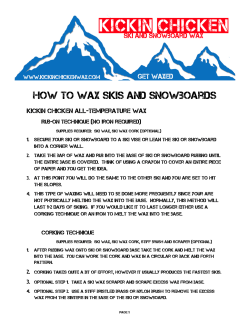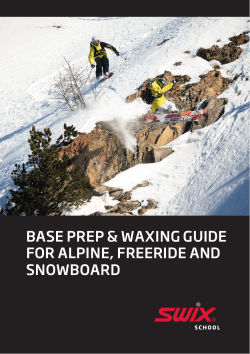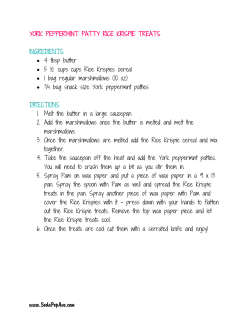
NORDIC SKIING WAXING GUIDELINES
NorsemanSki.com NORDIC SKIING WAXING GUIDELINES Remember the day when you had a perfect track and perfect wax on your skis? It was no doubt a wonderful zen like experience with skis that glided effortlessly and km melted away. You couldn’t believe how far you had gone in so little time. With properly prepared skis, some experience and good advice, these days will quickly become more common. Classic Waxable Ski Anatomy A classic ski has two main sections, the grip (or kick) zone which is waxed for traction, and the glide zones (tip & tail) which are waxed for glide. The grip zone is located beneath the binding from about the back of heel plate to 30 cm above the toe - grip wax (also known as kick wax) is applied to this area to provide the grip (this is where you would see a scale or pattern on a waxless ski base). The tips and tails of the ski are glide zones and are waxed for glide, similar to a downhill ski. In a properly sized classic ski, when a skier stands on the skis, the middle part of the ski (ie the kick zone) will be slightly off the snow so the kick wax does not contact the snow while gliding. When a skier shifts their weight to the kicking ski, the ski flattens and the grip wax contacts the snow and provides grip. As the skier finishes the kick, the wax releases from the snow and the skier glides on the tips and tails. For this to work well, skis need to be properly sized for the skier’s weight and kick zones accurately determined. We are happy to test your skis in the store and mark the kick zones for you. Preparing skis for the season Your skis may have been sitting in the garage since last ski season and may have old wax, pine needles, road grime and/or garage dust on them. This makes for very slow skis unless you clean them up. Start by scraping off old wax using a plastic scraper. Use wax cleaner and fiberlene to get the remainder. If you are hot waxing your glide zones, this should be done before the next step). See “Glide Waxing” below for details. If you know where your kick zone is, lightly sand most of this area (up to a few inches short each end) with 100 to 150 grit sandpaper. Next, apply one thin layer of base binder to this area. Cork it in and then apply some heat (heat gun, iron or hair dryer) to slightly melt the wax, then cork again until smooth. Now your skis are ready for the kick wax of the day. Applying Kick (or grip) waxes These are usually put on at the trailhead based on temperatures and current snow conditions (ie either fresh or old snow). If you start with a clean ski or skis with just base binder, you should apply 3 or more layers, corking each layer smooth. Start by crayoning on an even thin layer to the kick area, using gentle pressure to avoid getting big globs of wax on your ski. Next, cork the wax smooth by holding the tip up with the tail on the ground. Rest the ski against your thigh and apply even pressure on the cork with your free hand to rub in the wax. Repeat for two to three more layers. The grip zone should be evenly covered with kick wax which has been corked smooth. Common wax problems: Not enough grip (Sliding backwards): The ski slips when you try to push off the ski. This can be caused by not enough wax, wax that is not sticky enough, or too little wax. Try adding another layer or 2 of the same wax as you were using. If that doesn’t work, try extending the grip zone by waxing a few inches higher and lower on the grip pocket. Next, try a stickier wax (ie a wax for warmer temperatures). If this problem persists time after time and your friend’s skis are fine with the same wax, your skis may be too stiff for your weight (the Norseman can test your skis to check this) or there may be problems with your technique (particularly on uphill tracks – a hill lesson may well help here). Skis don’t glide very well (Sticky skis): This can be due to a number of reasons: Old wax on the skis that is too sticky for today’s snow, or the skis are dirty (old wax, pine needles, dog hair, lint/dirt from the car, etc). The best solution is to clean the skis and apply a fresh base binder (see “Preparing skis for season”). It’s generally best to transport skis in a ski bag to protect them, protect you from the skis, and avoid picking up debris from your car trunk or dust in the air (a bag also helps for storage). The wax you just applied is too sticky for today’s snow. If skis are just a bit slow, try putting a colder layer of wax over top, this should help speed them up. If snow is also building up on bases and/or you are walking on snow stilts, scrape all that sticky wax off and reapply 2 or more layers of a bit colder (less sticky) wax. Make sure you bring a scraper with you. Your skis are too soft for your weight. This means that your kick wax is always dragging on the snow and slowing you down. The Norseman can test the camber of your skis to check this if you feel it is a concern. Skis are not glide waxed regularly. Waxing protects the bases, makes them glide faster, and prevents base oxidation which degrades the base and slows skis down. Kick Wax Selection Wax selection is dictated by snow temperature, humidity and the type of snow (ie fresh, old, man made). A stickier (warmer) wax is usually required for older snow versus new snow. Waxes have temperature ranges on the tins and some waxes such as Swix show ranges for both old and new snow. In any case if you do not have enough grip, or your skis are too grippy (snow is sticking), try the suggestions listed under “Common wax problems” above. It also helps to know your waxes, ie: which is stickier and which is less sticky so you can adjust wax to correct problems. A wider selection of waxes (especially for temperature close to zero) helps to fine tune this. Keen waxers can keep notes on temperature, snow conditions and wax each time they ski to get a better feel for this. The Norseman can provide advice in this regard and suggest waxes to complement what you already have in your kit. There are many different brands and lines of waxes, some of which work better in certain conditions than others (ie fresh snow versus old or man-made snow). For example the Swix VR line is a fluorinated kick wax which is less prone to icing, glides better and is more durable than the V line Swix waxes, so it is better for longer distances. Start also makes fluorinated waxes with Molybedium, they are excellent on manmade snow (such as typically exists at Canmore or Canada Olympic Park) and old snow in local areas such as West Bragg Creek and Shaganappi when it hasn’t snowed for some time. In abrasive snow conditions all waxes will last the longest when applied on top of an ironed on base binder wax such as Swix VG35. Klister (a semi-fluid wax in tubes) can also be used as a binder (Swix KR20) when the snow is icy and very abrasive. For icy and very warm conditions, klister is sometimes the only wax that will provide grip and is durable enough to stay on the skis for a reasonable length of time. Klisters are applied by squeezing a thin line or frequent dabs on the base of the ski. Spread into a thin layer by a thumb or with the plastic scraper usually provided in the klister box. Skins For backcountry skiing, skins (either partial or full length) provide good grip on long climbs through changing snow conditions, and control speed during the descent. Skins have a built-in glue surface designed to hold the skin against the surface of your ski, but it should not be placed on a ski base waxed with a kick wax. After the skin is removed, the base should cleaned to prevent the glue from mixing with wax (and totally ruining your glide). Advanced Waxing Techniques New Ski preperation Ideally the glide zones of new skis should be saturated with a base prep wax (such as Swix BP99). This protects the ski from oxidation/degradation of the base, and makes the glide wax of the day more durable. Start by “hot scraping” the skis by ironing in a soft glide wax (such as CH10 or BP99), and then immediately scrape the excess hot wax off the ski. Next brush the ski with a brass brush and apply BP99 which is a soft base prep wax that should be ironed in 10 or more times about every 15 min. Be very careful not to overheat and damage the ski base. Let the ski cool, scrape off the wax and brush the ski with a brass brush then iron in a harder glide wax (CH6 or LF6) several times. Let ski cool and then scrape/brush. Repeat the base prep wax with multiple meltings. Go to “swixschool.no”, Racing section and then New Skis for more info. Alternatively we can “hot box” the skis for you, this saturates the base with base prep wax. Glide Waxing Glide waxing protects the bases, makes them glide faster, and prevents base oxidation (which degrades the base and slows skis down). Improved glide can be obtained by ironing glide waxes into glide areas (tips and tails). Universal gliders U10 and U20 are the most economical, however better performances can be obtained by applying temperature specific Swix CH (Hydrocarbon - training), or LF (Low fluorocarbon - race), or Cera HF (high fluorocarbon – high level race) gliders. To start, brush the glide areas (tips and tails of classic skis or full ski for skate skis) with a brass brush to remove old wax, dirt and oxidation from the base. Using an iron set to proper wax temperature, push wax against tip of the iron to melt wax about one drop every 3-5 cm on both sides of the centre groove. Then iron glide areas of ski in one continuous motion to evenly melt wax into the base. To prevent overheating and ski damage, keep a layer of wax between the iron and the ski base and always keep the iron moving. The iron should be hot enough to leave wax molten for a few seconds after you pass the area. If the wax smokes, your iron is too hot. After cooling, the excess wax is scraped off with a plastic scraper, brushed with a brass brush, and then with a nylon brush to open up the base structure. The groove and sides are then cleaned with a plastic groove scraper. In warmer conditions, above about -5C, the bases can be structured for different snow conditions to optimize glide. This helps break the suction between bases and warmer snow. Structuring tools are used for this and create grooves or patterns in the ski base. Cleaning skis, hot waxing and structuring are best done when the ski is clamped horizontally at table top level. There are a number of clamps, ski forms and work tables available to facilitate this. Both cleaning and ironing should be done in a well ventilated work area. Waxless Skis Waxless skis still need to be waxed for better glide and to protect the base. The simplest method is to apply a liquid or paste “Easy Glide” universal glider to the entire base and let it dry. Ideally a polishing brush should be used to work this paste into the base. Tips and tails can also be waxed for glide by using either the crayoning or ironing methods. Specific ‘scale’ waxes are also available for grip zones. It is always important that wax is not pushed beneath the kick zone ‘scales’ as this will reduce traction enourmously. Repairs Minor damage to skis such as delamination of tails caused by skiing backwards, waxing skis in parking lots or standing skis in a snow bank can be repaired by a Norseman technician. Gouges or scratches in the base are repaired by dripping hot Polystick into the damaged area and scraping the excess off. A metal scraper will remove small physical surface irregularities. Accumulated scratches and damage to the base due to oxidation can be removed by refinishing the base surface with stone grinding. Oxidation shows up as white streaks or areas in the otherwise black ski base. End of season storage Skis are best protected during the off-season storage by first cleaning the kick area thoroughly (scrape excess kick wax and clean remainder with wax cleaner and fiberlene). Lastly, iron in a “Base Prep BP88” travel wax or a similar warm glider bulk wax to the glide areas to protect them during the off season. Use a ski bag or store skis or place them in a clean, dust free area.
© Copyright 2025
















